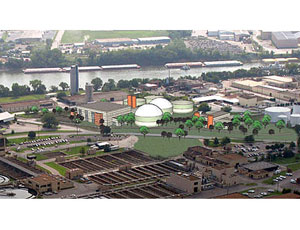A memorable date for Nashville’s water department will be Memorial Day Weekend, when it expects to put back online the K.R. Harrington Water Treatment Plant, which was under water after the city’s May 1-2 flooding.

Northeast of downtown and near the Cumberland River, the plant has a rated capacity of 90 million gallons per day (mgd).
Since the plant has been down, the city has been under a mandatory water conservation order because the only other water-treatment operation, the Omohundro Water Treatment Plant, also is rated for only 90 mgd.
Nashville’s average daily water use is approximately 100 mgd.
“We expect the conservation order to be lifted once K.R. Harrington is back online,” says Sonia Harvat, spokeswoman for Metro Water Services, which serves metropolitan Nashville.
Nashville has been getting water from surrounding systems, including the Madison Suburban, West Wilson and Harpeth Valley utility districts, and its reservoir is back to 85% capacity after dropping to less than 40% immediately after the flood, prompting the conservation order.
Crews are continuing repairs of the flood-damaged Dry Creek Wastewater Treatment Plant, which is located north of town. Dry Creek is one of four wastewater-treatment operations.
Currently, there is no estimated completion date, Harvat says.
Federal Emergency Management Agency officials estimated Metro Water Services repair costs at $200 million, including $40 million for the Harrington plant and $100 million for the Dry Creek plant, though complete assessments are not yet available, Harvat says.
Those costs are not included in the $1.9-billion private-property damage in Nashville identified by inspection teams who toured flooded areas. They checked out more than 11,000 parcels with more than 16,800 homes.
Metro agencies are reporting another $42 million in flood damages.
The flooding occurred after 13.5 in. of rain fell in about 36 hours, and the Cumberland River and its tributaries—such as Mill Creek, Richland Creek, Whites Creek and the Harpeth River—overran their banks, flooding downtown and suburban areas.
The city hired Gresham Smith & Partners, a Nashville-based engineering and architecture firm, to work on the Harrington plant. Crews are draining and inspecting clear wells and replacing the plant’s main transformer and electrical wiring as well as its water-quality instruments, valves and actuators.
Scott Potter, Metro Water Services director, said that once the repairs are completed, water would be tested by the Tennessee Dept. of Environment and Conservation and an independent outside firm to determine if it is safe and meets all state and federal drinking- water requirements.
Engineering consultant Brown & Caldwell, with an office in Nashville, has the contract for the Dry Creek plant, which has a 54-mgd peak capacity and an average daily flow of about 18 mgd. It was built in 1961.
Black & Veatch Corp., also with an office in Nashville, has the contract for the biosolids facility that processes sludge from the Central Wastewater Treatment Plant, which serves downtown.
The Central plant, built in 1959, and the Whites Creek Wastewater Treatment Plant, built in 1975 and located west of town, also had flood damage. “But [it was] not as substantial as Dry Creek,” Harvat says.
Meanwhile, although 115 roads were barricaded after the flood, only one road remains closed to traffic. The sole detour is Pumping Station Road, near the Harrington water plant, says Gwen Hopkins-Glascock, spokeswoman for Metro Public Works.
Two bridges, on Tucker and Morrow roads, had “significant scour,” Hopkins-Glascock says, but they have been repaired.
Six other roads are being monitored for slope movement and possible slides.
Private owners also are securing rehab permits for flood repairs and rehabilitation; for example, American Constructors Inc., Nashville, received $15 million in damages for the Schermerhorn Symphony Center for flooding to the center’s basement and all its mechanical equipment.
Other big permits are Batten & Shaw Inc.’s $1.5 million in damages for the ground floor of the Women’s Hospital at Centennial; Beech Construction Services Inc.’s $3 million for the Gaylord Entertainment sales-and-marketing office, the Wildhorse Saloon and Opryland’s golf-course buildings and pump house; and Brasfield & Gorrie LLC’s $2 million for the Pinnacle office building.


Post a comment to this article
Report Abusive Comment